Page 141 of 416
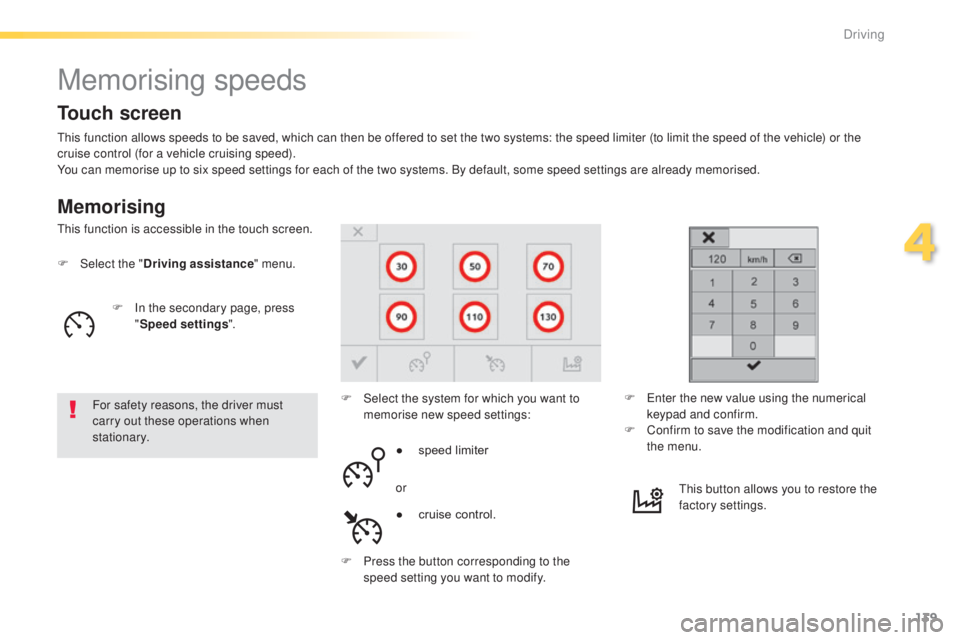
139
308_en_Chap04_conduite_ed01-2015
Memorising speeds
Memorising
this function allows speeds to be saved, which can then be offered to set the two systems: the speed limiter (to limit the speed of the vehicle) or the
cruise control (for a vehicle cruising speed).
You can memorise up to six speed settings for each of the two systems. By default, some speed settings are already memorised.
F
Sel
ect the " Driving assistance " menu.
For safety reasons, the driver must
carry out these operations when
stationary. F
S
elect the system for which you want to
memorise new speed settings:
th
is function is accessible in the touch screen.
F
e
n
ter the new value using the numerical
keypad and confirm.
F
C
onfirm to save the modification and quit
the menu.
●
s
peed limiter
or
F
P
ress the button corresponding to the
speed setting you want to modify.
th
is button allows you to restore the
factory settings.
Touch screen
F In the secondary page, press "Speed settings ".
●
c
ruise control.
4
Driving
Page 148 of 416
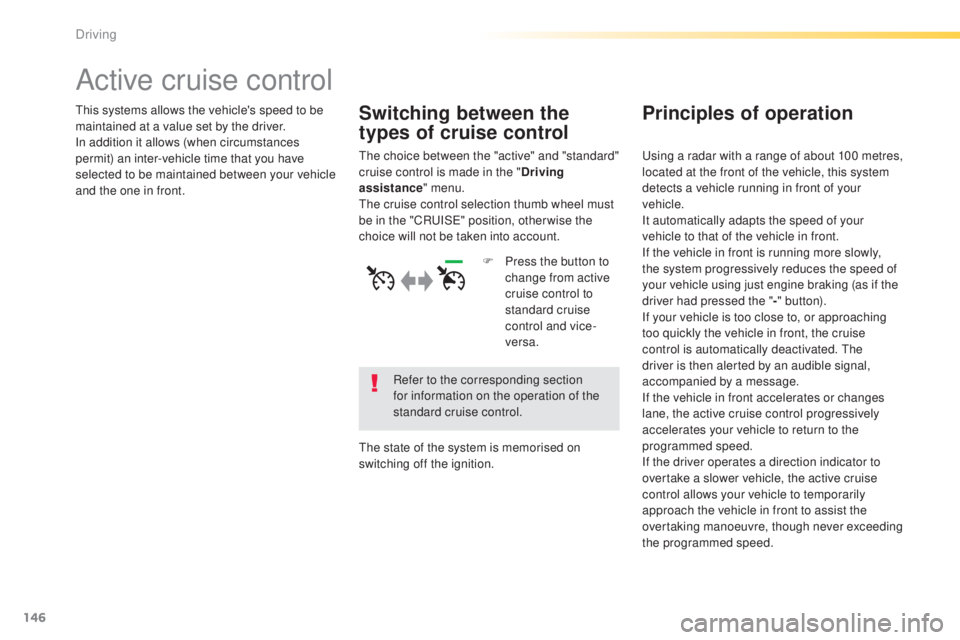
146
308_en_Chap04_conduite_ed01-2015
Active cruise control
this systems allows the vehicle's speed to be
maintained at a value set by the driver.
In addition it allows (when circumstances
permit) an inter-vehicle time that you have
selected to be maintained between your vehicle
and the one in front.Principles of operation
using a radar with a range of about 100 metres,
located at the front of the vehicle, this system
detects a vehicle running in front of your
vehicle.
It automatically adapts the speed of your
vehicle to that of the vehicle in front.
If the vehicle in front is running more slowly,
the system progressively reduces the speed of
your vehicle using just engine braking (as if the
driver had pressed the "-" b ut to n).
If your vehicle is too close to, or approaching
too quickly the vehicle in front, the cruise
control is automatically deactivated.
t
h
e
driver is then alerted by an audible signal,
accompanied by a message.
If the vehicle in front accelerates or changes
lane, the active cruise control progressively
accelerates your vehicle to return to the
programmed speed.
If the driver operates a direction indicator to
overtake a slower vehicle, the active cruise
control allows your vehicle to temporarily
approach the vehicle in front to assist the
overtaking manoeuvre, though never exceeding
the programmed speed.
Switching between the
types of cruise control
the choice between the "active" and "standard"
cruise control is made in the " Driving
assistance " menu.
th
e cruise control selection thumb wheel must
be in the "CR
uI
S
e" p
osition, other wise the
choice will not be taken into account.
Refer to the corresponding section
for information on the operation of the
standard cruise control.
th
e state of the system is memorised on
switching off the ignition. F
P
ress the button to
change from active
cruise control to
standard cruise
control and vice-
versa.
Driving
Page 150 of 416
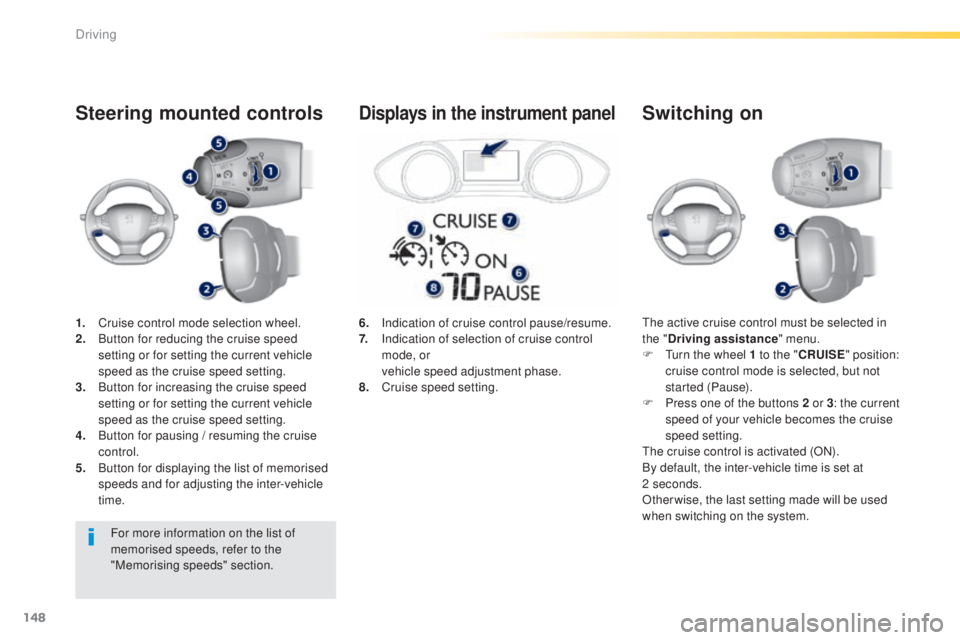
148
308_en_Chap04_conduite_ed01-2015
1. Cruise control mode selection wheel.
2. Button for reducing the cruise speed
setting or for setting the current vehicle
speed as the cruise speed setting.
3.
B
utton for increasing the cruise speed
setting or for setting the current vehicle
speed as the cruise speed setting.
4.
B
utton for pausing / resuming the cruise
control.
5.
B
utton for displaying the list of memorised
speeds and for adjusting the inter-vehicle
time.
Steering mounted controls
the active cruise control must be selected in
the " Driving assistance " menu.
F
t
u
rn the wheel 1 to the " CRUISE" position:
cruise control mode is selected, but not
started (Pause).
F
P
ress one of the buttons 2 or 3 : the current
speed of your vehicle becomes the cruise
speed setting.
th
e cruise control is activated (ON).
By default, the inter-vehicle time is set at
2
seconds.
Otherwise, the last setting made will be used
when switching on the system.
Switching on
6. Indication of cruise control pause/resume.
7. I ndication of selection of cruise control
mode, or
v
ehicle speed adjustment phase.
8.
C
ruise speed setting.
Displays in the instrument panel
For more information on the list of
memorised speeds, refer to the
"Memorising speeds" section.
Driving
Page 156 of 416
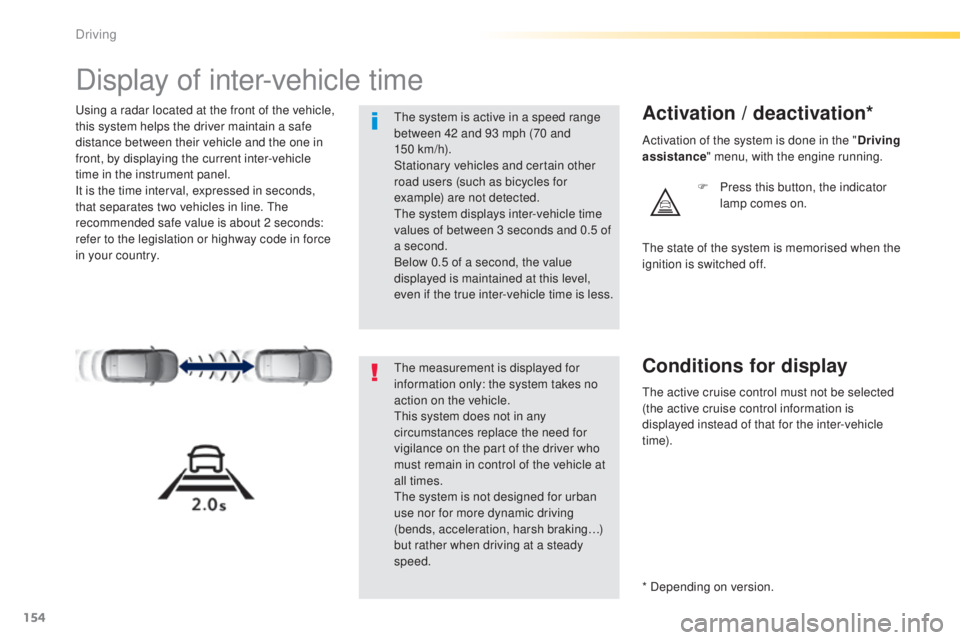
154
308_en_Chap04_conduite_ed01-2015
Display of inter-vehicle time
using a radar located at the front of the vehicle,
this system helps the driver maintain a safe
distance between their vehicle and the one in
front, by displaying the current inter-vehicle
time in the instrument panel.
It is the time interval, expressed in seconds,
that separates two vehicles in line. t
h
e
recommended safe value is about 2 seconds:
refer to the legislation or highway code in force
in your country.Activation / deactivation*
F Press this button, the indicator lamp comes on.
th
e measurement is displayed for
information only: the system takes no
action on the vehicle.
th
is system does not in any
circumstances replace the need for
vigilance on the part of the driver who
must remain in control of the vehicle at
all times.
th
e system is not designed for urban
use nor for more dynamic driving
(bends, acceleration, harsh braking…)
but rather when driving at a steady
speed.
th
e system is active in a speed range
between 42 and 93 mph (70 and
150
km/h).
Stationary vehicles and certain other
road users (such as bicycles for
example) are not detected.
th
e system displays inter-vehicle time
values of between 3 seconds and 0.5 of
a second.
Below 0.5 of a second, the value
displayed is maintained at this level,
even if the true inter-vehicle time is less.
th
e state of the system is memorised when the
ignition is switched off. Activation of the system is done in the " Driving
assistance " menu, with the engine running.
* Depending on version.
Conditions for display
the active cruise control must not be selected
(the active cruise control information is
displayed instead of that for the inter-vehicle
t i m e).
Driving
Page 160 of 416
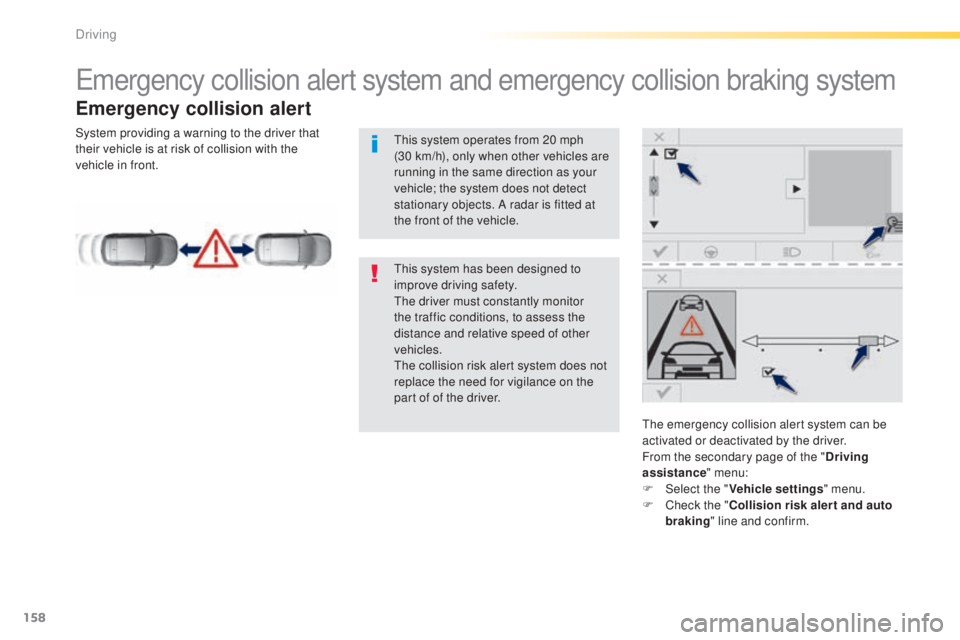
158
308_en_Chap04_conduite_ed01-2015
emergency collision alert system and emergency collision braking system
Emergency collision alert
the emergency collision alert system can be
activated or deactivated by the driver.
From the secondary page of the "Driving
assistance " menu:
F
Sel
ect the " Vehicle settings " menu.
F
C
heck the " Collision risk alert and auto
braking " line and confirm.
th
is system has been designed to
improve driving safety.
th
e driver must constantly monitor
the traffic conditions, to assess the
distance and relative speed of other
vehicles.
th
e collision risk alert system does not
replace the need for vigilance on the
part of of the driver.
th
is system operates from 20 mph
(30
km/h), only when other vehicles are
running in the same direction as your
vehicle; the system does not detect
stationary objects. A radar is fitted at
the front of the vehicle.
System providing a warning to the driver that
their vehicle is at risk of collision with the
vehicle in front.
Driving
Page 161 of 416
159
308_en_Chap04_conduite_ed01-2015
From the secondary page of the "Driving
assistance " menu:
F
Sel
ect the " Vehicle settings " menu.
F
C
heck the " Collision risk alert and auto
braking " line.
th
e alert thresholds determine how you want to
be alerted to the presence of a vehicle running
in front of you.
You can choose from three thresholds:
-
1
: "Distant", to be given an early alert
(cautious driving).
-
2
: "Normal".
-
3
: "Close", to be given a later alert (sporty
driving).
Setting the thresholds for the
alert
F Press on the magnifying glass. F
M
odify the alert threshold and press on
" Finish " to memorise the threshold and
leave the menu.
F
P
ress on "
Confirm" to save the change.
4
Driving
Page 163 of 416
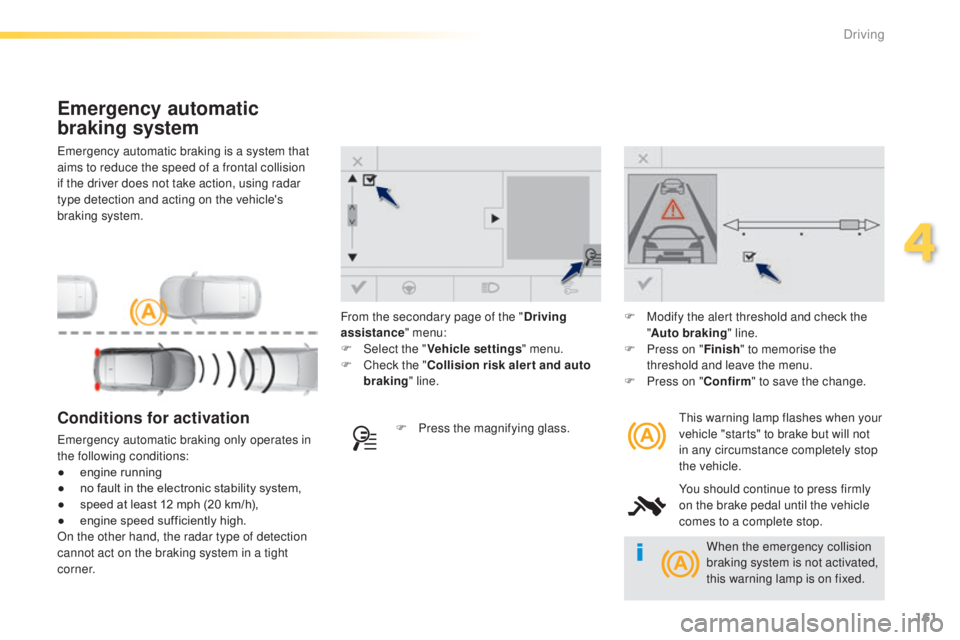
161
308_en_Chap04_conduite_ed01-2015
emergency automatic braking is a system that
aims to reduce the speed of a frontal collision
if the driver does not take action, using radar
type detection and acting on the vehicle's
braking system.
Emergency automatic
braking system
this warning lamp flashes when your
vehicle "starts" to brake but will not
in any circumstance completely stop
the vehicle.
You should continue to press firmly
on the brake pedal until the vehicle
comes to a complete stop.Conditions for activation
emergency automatic braking only operates in
the following conditions:
●
e
ngine running
●
n
o fault in the electronic stability system,
●
s
peed at least 12 mph (20 km/h),
●
e
ngine speed sufficiently high.
On the other hand, the radar type of detection
cannot act on the braking system in a tight
c o r n e r. F
P ress the magnifying glass.F
M
odify the alert threshold and check the
" Auto braking " line.
F
P
ress on "
Finish" to memorise the
threshold and leave the menu.
F
P
ress on "
Confirm" to save the change.
From the secondary page of the "
Driving
assistance " menu:
F
Sel
ect the "
Vehicle settings " menu.
F
C
heck the "
Collision risk alert and auto
braking " line.
When the emergency collision
braking system is not activated,
this warning lamp is on fixed.
4
Driving
Page 165 of 416

163
308_en_Chap04_conduite_ed01-2015
Blind spot sensors
Operation
A warning lamp appears in the door mirror on
the side in question:
-
i
mmediately, when being overtaken,
-
a
fter a delay of about one second, when
overtaking a vehicle slowly.th
is driving assistance system warns the driver
of the presence of another vehicle in the blind
spot angle of their vehicle (areas masked from
the driver's field of vision), as soon as this
presents a potential danger.
th
is indicator lamp comes on in the instrument
panel.
Sensors fitted in the front and rear bumpers
monitor the blind spots.
th
is system is designed to improve safety when driving and is in no circumstances a
substitute for the use of the interior rear view mirror and door mirrors. It is the driver's
responsibility to constantly check the traffic, to asses the distances and relative speeds of
other vehicles and to predict their movements before deciding whether to change lane.
th
e blind spot sensor system does not replace the need for vigilance on the part of the
driver. Activation of the system is done in
the "
Driving assistance " menu of
the touch screen.
F
Press this button (depending on
version) to activate the function; the
associated indicator lamp comes on.
4
Driving